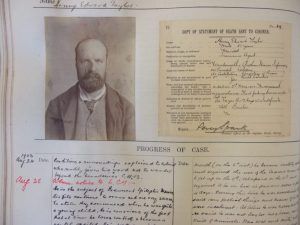Frankie Thomas in The Paris Review:
 “Are we all Joyceans here, then?” the young professor asked, poking his head into the classroom doorway.
“Are we all Joyceans here, then?” the young professor asked, poking his head into the classroom doorway.
We looked back at him uncertainly. Yes, we were all here for the Ulysses seminar that met at six thirty P.M. on Tuesdays and Thursdays. But to call us “Joyceans” seemed like a stretch. Today—Thursday, January 29, 2015—was only the first day. And besides, this was City College.
No article about City College is complete without the obligatory phrase “the Harvard of the proletariat,” which was supposedly both our school’s nickname and its reputation in the mid twentieth century. By 2015, however, no one could deny that our beautiful Harlem campus was in decline. Governor Cuomo had recently slashed the budget for the entire CUNY system, with City College bearing the brunt of the cuts, and the disastrousness of this decision is difficult to convey without resorting to sodomitic imagery. That year, classrooms were so overcrowded that latecomers had to sit on the floor. One of my professors entered his office on the first day to find that his entire desk had been stolen. The humanities building still used old-fashioned blackboards, but the budget didn’t provide for chalk, so professors hoarded and traded it like prison cigarettes. Most bathroom stalls didn’t lock, and for several weeks, the entire campus collectively ran out of toilet paper—I’ll never forget the Great Toilet Paper Crisis of 2015 and the generosity it inspired in my fellow students, who shared their own toilet paper from home and never stooped to charging for it.
It was in this context that the English department decided to offer its first-ever Ulysses seminar, though they offered it as you might offer someone a home-cooked meal that you’re secretly pretty sure contains broken glass. “NB: This is a highly demanding course with a heavy reading load,” the course catalogue warned in bold italics, “more like a graduate seminar than a 400-level college class.” I don’t think it actually said “DON’T TAKE THIS CLASS,” but that was the obvious implication. I have since learned that our idealistic young professor was met with departmental resistance when he suggested a Ulysses seminar, and I now suspect that the department was half hoping no one would register for it at all. But the department hadn’t counted on the sheer belligerence of City College students. I took one look at that warning and immediately decided, thanks to the same knee-jerk rebelliousness that had led me to avoid college until the age of twenty-seven, that I had to take this class. I wasn’t the only one: there were thirty students in the Ulysses seminar. (This is what passes for a small discussion class at City College.)
Were we all Joyceans here, then? Taking our silence as a yes, our professor stepped into the crowded classroom.
More here.

 Media coverage of uncontacted tribes often delights in painting indigenous groups as people out of time, hunter-gatherers in the age of Seamless. In November, an American missionary was killed trying to reach North Sentinel Island in the Bay of Bengal, home to a remote tribe thought to number about 100 people. Grainy images shot from a helicopter in 2004 of naked islanders brandishing spears flooded the internet. But when they first appear in Piripkura, Pakyî and Tamandua offer a different kind of spectacle. What is striking about them is not their timelessness, but rather their very modern resolve to persist against the odds, to be free from the outside world.
Media coverage of uncontacted tribes often delights in painting indigenous groups as people out of time, hunter-gatherers in the age of Seamless. In November, an American missionary was killed trying to reach North Sentinel Island in the Bay of Bengal, home to a remote tribe thought to number about 100 people. Grainy images shot from a helicopter in 2004 of naked islanders brandishing spears flooded the internet. But when they first appear in Piripkura, Pakyî and Tamandua offer a different kind of spectacle. What is striking about them is not their timelessness, but rather their very modern resolve to persist against the odds, to be free from the outside world. Nearly two decades ago, photo historian Douglas Nickel observed that traditional art history had not yet developed the tools for handling non-art photographs.
Nearly two decades ago, photo historian Douglas Nickel observed that traditional art history had not yet developed the tools for handling non-art photographs. Rooney’s second novel, “
Rooney’s second novel, “ Hundreds of doctors packed an auditorium at Memorial Sloan Kettering Cancer Center on Oct. 1, deeply angered by revelations that the hospital’s top medical officer and other leaders had cultivated lucrative relationships with for-profit companies. One by one, they stood up to challenge the stewardship of their beloved institution, often to emotional applause. Some speakers accused their leaders of letting the quest to make more money undermine the hospital’s mission. Others bemoaned a rigid, hierarchical management that had left them feeling they had no real voice in the hospital’s direction. “Slowly, I’ve seen more and more of the higher-up meetings happening with people who are dressed up in suits as opposed to white coats,” said Dr. Viviane Tabar,
Hundreds of doctors packed an auditorium at Memorial Sloan Kettering Cancer Center on Oct. 1, deeply angered by revelations that the hospital’s top medical officer and other leaders had cultivated lucrative relationships with for-profit companies. One by one, they stood up to challenge the stewardship of their beloved institution, often to emotional applause. Some speakers accused their leaders of letting the quest to make more money undermine the hospital’s mission. Others bemoaned a rigid, hierarchical management that had left them feeling they had no real voice in the hospital’s direction. “Slowly, I’ve seen more and more of the higher-up meetings happening with people who are dressed up in suits as opposed to white coats,” said Dr. Viviane Tabar,